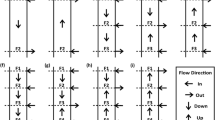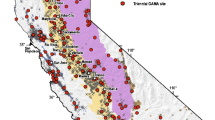Abstract
Open borehole wells in fractured crystalline rock are commonly used for domestic water supply. Concentrations of contaminants present in the well water, typically collected from the tap after some degree of purging, are weighted average concentrations. In this study, factors which influence sample concentrations collected from domestic wells are evaluated through the use of conceptual models and confirmatory field tests. Focus is on the extent of drawdown during sampling, distance between the pump inlet and contaminated fractures, relative fracture transmissivity, fracture discharge rate into the borehole, and the hydraulic head distribution of the fractures. Simplified spreadsheet models were developed to assess the relation between these factors and sample concentrations. The models show that in addition to fracture transmissivities, drawdown in relation to fracture head plays a significant role in how much water recharges a well from each fracture, yet it is rarely measured when sampling domestic wells. To evaluate the extent of drawdown that may occur under typical household usage, water levels were monitored in three domestic wells. Pumping tests were conducted in three wells to measure changes in concentration as a function of pumping duration. Downhole profiling was conducted to examine how pumping induces changes to water quality within the wellbore. The results indicate that these factors can have a strong influence on contaminant concentrations in samples collected from these wells. As such, the weighted averaging factors should be considered in sample collection, in data interpretation, in assessing exposure risk and in mapping contaminant distributions.







Similar content being viewed by others
References
Brainerd RJ, Robbins GA (2004) A tracer dilution methodfor fracture characterization in bedrock wells. Groundwater 42(5):774–780
Cagle MB (2005) Fracture hydrogeology of two wells in crystalline bedrock located in a glacial upland in Connecticut. Masters Thesis, University of Connecticut, Storrs
Elci A, Molz FJ III, Waldrop WR (2001) Implications of observed and simulated ambient flow in monitoring wells. Groundwater 39(6):853–862. https://doi.org/10.1111/j.1745-6584.2004.tb02461.x
Flahive N (2017) A single packer method for characterizing water contributing fractures in cyrstalline bedrock wells. Masters Thesis, University of Connecticut, Storrs
Harte PT (2017) In-well time-of-travel approach to evaluate optimal purge duration during low-flow sampling of monitoring wells. Environ Earth Sci 76:251. https://doi.org/10.1007/s12665-017-6561-5
Johnson CD, Haeni FP, Lane JW, White EA (2002) Borehole-geophysical investigation of the University of Connecticut landfill, Storrs, Connecticut. In: U.S. Geological Survery Water-Resources Investigations Report 2001–4033
Libby JL, Robbins GA (2013) An unsteady state tracer method for characterizing fractures in bedrock wells. Groundwater 52(1):136–144. https://doi.org/10.1111/gwat.12045
Martin-Hayden JM, Robbins GA (1997) Plume distortion and apparent attenuation due to concentration averaging in monitoring wells. Groundwater 35(2):339–347. https://doi.org/10.1016/j.jconhyd.2014.05.005
McMillan LA, Rivett MO, Tellam JH, Dumble P, Shaarp H (2014) Influence of vertical flows in wells on groundwater sampling. J Contam Hydrol 169(10):50–56. https://doi.org/10.1016/j.jconhyd.2014.05.005
Metcalf MJ, Robbins GA (2007) Comparison of water quality profiles from shallow monitoring wells and adjacent multilevel samplers. Groundw Monit Rem 27(1):84–91. https://doi.org/10.1111/j.1745-6592.2006.00126.x
Molofsky LJ, Richardson SD, Gorody AW, Baldassare F, Connor JA, McHugh TE, Smith AP, Wylie AS, Wagner T (2018) Purging and other sampling variables affecting dissolved methane concentration in water supply wells. Sci Total Environ 618:998–1007. https://doi.org/10.1016/j.scitotenv.2017.09.077
Ogata A, Banks RB (1961) A solution of the differention equation of longitudinal dispersion in porous media. U.S. Geologicl Survey Professional Paper 411-A
Rhode Island Department of Environmental Management (RI DEM) (2010) Standard operating procedure: residential well sampling (for chemical analysis). Field Sampling SOPNo: WP-22
Shapiro AM (2002) Cautions and suggestions for geochemical sampling in fractured rock. Groundw Monit Rem 22(3):151–164. https://doi.org/10.1111/j.1745-6592.2002.tb00764.x
Sokol D (1963) Position and fluctuations of water level in wells perforated in more than one aquifer. J Geophys Res 68(4):1079–1080. https://doi.org/10.1029/JZ068i004p01079
State of Connecticut Department of Public Health (CT DPH) (2009) Private drinking water in Connecticut. Sampling Private Wells for Bacteria No. 38
Taylor G (1954) The dispersion of matter in turbulent flow through a pipe. Proc R Soc A Math Phys Eng Sci 223(1155):446–468. https://doi.org/10.1098/rspa.1954.0130
TsangCF HP, Hale FV (1990) Determination of fracture inflow parameters with a borehole fluid conductivity logging method. Water Resour Res 26(4):561–578
US Environmental Protection Agency (US EPA Region 1) (2015) New England states' sample collection and preservation guidance manual for drinking water, Rev. 5.0January 2015
US Environmental Protection Agency Regional 8 Laboratory (US EPA Region 8) (2016) Quick guide to drinking water sample collection, 2nd edn
Vitale SA, Robbins GA (2017) Measuring water quality from individual fractures in open wellbores using hydraulic isolation and the dissolve oxygen alteration method. Hydrogeol J 25(7):2199–2206. https://doi.org/10.1007/s10040-017-1657-2
World Health Organization, Geneva (WHO) (1997) Guidelines for drinking-water quality, Second Edition, v.3. Surveillance and control of community supplies
Author information
Authors and Affiliations
Contributions
MAH: Conceptualization, Methodology, Investigation, Writing—original draft, Writing—review and editing, Visualization, Project administration. GAR: Conceptualization, Methodology, Investigation, Resources, Writing—review and editing, Supervision, Funding acquisition. MJM: Conceptualization, Methodology, Investigation.
Corresponding author
Additional information
Publisher's Note
Springer Nature remains neutral with regard to jurisdictional claims in published maps and institutional affiliations.
Rights and permissions
About this article
Cite this article
Higgins, M.A., Robbins, G.A. & Metcalf, M.J. An assessment of hydrologic factors that influence contaminant concentrations determined from domestic well-water samples. Environ Earth Sci 79, 388 (2020). https://doi.org/10.1007/s12665-020-09133-w
Received:
Accepted:
Published:
DOI: https://doi.org/10.1007/s12665-020-09133-w




